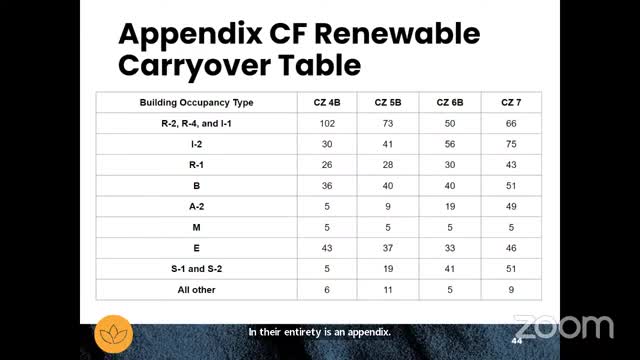Experts warn of building code compliance nightmare
July 26, 2024 | Energy Office, State Agencies, Organizations, Executive, Colorado

This article was created by AI summarizing key points discussed. AI makes mistakes, so for full details and context, please refer to the video of the full meeting. Please report any errors so we can fix them. Report an error »

In a recent government meeting, officials and industry experts discussed the complexities and challenges surrounding energy efficiency credits in building codes, particularly the 2021 International Energy Conservation Code (IECC) and its implications for developers and architects. The conversation highlighted the difficulties in navigating the current system, which many participants described as a \"tangled mess.\"
Participants expressed concerns about the cost implications of compliance with the energy credits, noting that the financial impact varies significantly depending on the specific credits chosen. The complexity of the compliance process was a recurring theme, with developers struggling to identify cost-effective pathways amidst overlapping requirements and a lack of clarity in the software tools designed to assist them.
Elizabeth, a designer in the field, emphasized the challenges posed by the current compliance software, stating that it often requires teams to \"fake\" their credit calculations just to check basic envelope compliance. This situation has led to frustration among professionals who find the existing tools inadequate for practical application. The discussion also touched on the recent modifications made by Denver to its building code, which have not yet been reflected in updated compliance software, further complicating the situation for local developers.
The group acknowledged that the issues stem not only from the complexity of the code itself but also from the inadequacies of the software used to demonstrate compliance. Participants warned that if the system becomes any more complicated, many may opt to comply with alternative standards, such as ASHRAE, which are perceived as simpler and more user-friendly.
As the meeting progressed, suggestions were made to consider moving the additional efficiency credit tables to an optional appendix in future code cycles. This change could potentially streamline compliance and promote uniformity across jurisdictions. The board is now tasked with evaluating various options for modifying the credit system, with an emphasis on reducing complexity to ensure that the codes are practical and accessible for all stakeholders involved.
Participants expressed concerns about the cost implications of compliance with the energy credits, noting that the financial impact varies significantly depending on the specific credits chosen. The complexity of the compliance process was a recurring theme, with developers struggling to identify cost-effective pathways amidst overlapping requirements and a lack of clarity in the software tools designed to assist them.
Elizabeth, a designer in the field, emphasized the challenges posed by the current compliance software, stating that it often requires teams to \"fake\" their credit calculations just to check basic envelope compliance. This situation has led to frustration among professionals who find the existing tools inadequate for practical application. The discussion also touched on the recent modifications made by Denver to its building code, which have not yet been reflected in updated compliance software, further complicating the situation for local developers.
The group acknowledged that the issues stem not only from the complexity of the code itself but also from the inadequacies of the software used to demonstrate compliance. Participants warned that if the system becomes any more complicated, many may opt to comply with alternative standards, such as ASHRAE, which are perceived as simpler and more user-friendly.
As the meeting progressed, suggestions were made to consider moving the additional efficiency credit tables to an optional appendix in future code cycles. This change could potentially streamline compliance and promote uniformity across jurisdictions. The board is now tasked with evaluating various options for modifying the credit system, with an emphasis on reducing complexity to ensure that the codes are practical and accessible for all stakeholders involved.
View full meeting
This article is based on a recent meeting—watch the full video and explore the complete transcript for deeper insights into the discussion.
View full meeting
